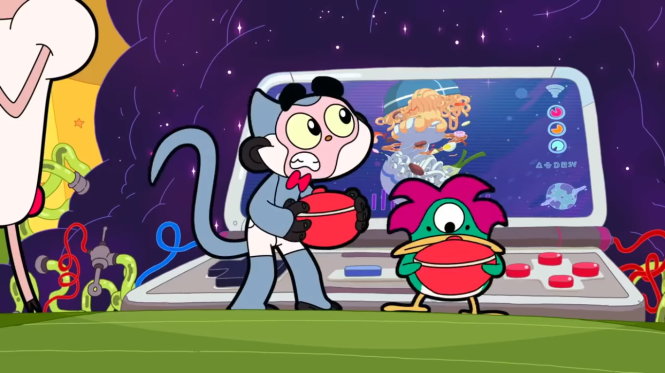The launch of a new Vietnamese animation studio and its products is seen as throwing stones into the still pond of the local animation industry, illuminating hope for change in a field full of potential but few people dare to dip their toes in.
VinTaTa is an in-house animation studio established by Vietnam’s leading conglomerate Vingroup in 2016, with an aim of creating truly made-in-Vietnam media products for local children.
Earlier last month, VinTaTa premiered its first-ever work - a cartoon series titled Monta trong Dai ngan ha ky cuc, which translates to ‘Monta in the Ridiculous Galaxy.’
On August 6, Monta had its first public screening at Landmark 81’s CGV cineplex in Ho Chi Minh City where audience could watch the first three episodes in the series, each spanning 20 minutes.
The animated work revolves around the titular character Monta – a Delacour’s langur – and his adventures across the universe with a ragtag group of unique friends.
Considered one of the world’s most endangered primates, the Delacour’s langur is exclusively endemic to northern Vietnam.
In the series, Monta works as an apprentice in the Universe Kitchen, where the Supreme Chef creates planetary stews.
However, Monta’s mischief leads to chaos in the kitchen, creating a host of strange new planets. As the punishment, Monta must restore the universal order himself.
Joining the langur on his journey are Sharkira the vegetarian shark, Sheepora the furless sheep, Pekka the acrophobic wookpecker, Wally the goldfish and Banana the shape-shifting banana.
Money talks
A team of 70 illustrators spent six months creating 7,200 paintings each week, matching the international format for animation, to be able to produce the three Monta episodes, which run a total of 60 minutes.
This is an unprecedented record, in terms of workload, for Vietnam’s animation industry in general, and for domestic 2D animation in particular.
Before ‘Monta in the Ridiculous Galaxy,’ a 20-minute animation on a popular historic legend Con Rong Chau Tien (Offspring of Dragon and Fairy) was produced under the investment of a footwear company.
The cartoon was the fruit of 100 artists, who completed 10,000 working hours within over 180 days.

In April, a five-episode historical animated film Loa thanh ruc lua, literally known as ‘Flaming Co Loa Citadel,’ by Hacthanstudio – a team of Vietnamese artists with ambition to make a fantasy, time-travel cartoon series – also delivered a teaser to Internet users.
National broadcaster Vietnam Television (VTV), after the establishment of VTV7 channel in 2016, has paid more attention to animation, with seven animated films – each of which runs for five to seven minutes – currently on air.
However, as the size of its personnel and investment in techniques and equipment remains modest, VTV7’s animated products are not abundant and are broadcast in repeat.
The longest record in the channel’s history was the animation series Ngay xua co tich, or ‘Old fairy tale,’ with each ten-minute episode created in a combination of a form of puppet theatre art, wherein a dramatic story is told through shadows thrown by puppets – and computerization.
But it is obvious that these animated products cannot be compared to ‘Monta in the Ridiculous Galaxy’ in terms of ‘smoothness’ between frames.
The VinTaTa artists would only pick one out of six drawings for every frame, a rate other artists can only dream of, not to mention the speed of production team.
According to an artist from Vietnam Animation Film Company, VinTaTa's films have smooth motion thanks to its high budget, which allows the illustrators to drop any drawing unsatisfying.
“We cannot even draw many illustrations, not to mention dropping a drawing,” the artist revealed.
“If we discontinue a drawing, we won’t have money to start it over,” he said.
Phuong Hoa, a veteran director in Vietnamese animation industry, likewise attributed VinTaTa’s preeminence to its modern studio system and a very young team of artists.
“Having someone who dares to pour money into professional animation is a very good signal for the [animation] industry,” Hoa said.
‘Scattered’ production
Before VinTaTa, state-owned Vietnam Animation Film Company was the only professional animation producer in Vietnam.
The company has undergone privatalization, with the government still holding the majority of shares and maintaining the production model.
This results in the fact that the company functions nearly in the same way as it was during the time of a centrally-planned economy when goods were not traded in the market, but distributed through coupons.
In recent years, the company is state-funded to make 160 minutes of animation each year, corresponding to 16 ten-minute movies.
Its mission is to fulfill the ‘quota’ of animated movies needed to produce every year, and promote them free-of-charge to as many viewers as possible.
This rigid mechanism has made the firm to produce animations with only two or one episode each.
This low volume of production has discouraged local broadcasters from buying and airing the works, even though they have good quality and meet the interest of Vietnamese children.
But Vietnam Animation Film Company has tried to change the situation in recent years.
The company decided to release the animation works on paid TV channels and the social networks of three mobile operators, VinaPhone, MobiFone and Viettel, and its YouTube channel.
The good news is that the company's YouTube channel has accumulated around 500 million views and half a million subscribers, with one of its films even garnering 50 million views.
Despite good signal from Vietnam Animation Film Company’s products, which proved that the demand for animation in the country is very large, few private firms dare to start long-term investment in animation.
Most of the animated products in the market only became phenomenon for a short time and quickly faded away.
Occasionally, there are animation films developed by certain companies for advertising and branding purposes.
In 2011, two 3D animated films Duoi bong cay (Under tree shadow) by Colory Animation Studio and Co be ban diem (The Little Match Girl) by True D Animation appeared as hits in Vietnam.
These projects gave the public more confidence that Vietnamese artists can make 3D animations. But since then, new products of these two studios remain nowhere to be seen.
Animation director Minh Tri expressed his sympathy for young artists that have no chance to continue after their initial successful works.
“Many of them joined different studios in Ho Chi Minh City, getting hired by South Korean, Japanese, or French producers, with their mature techniques,” Tri said.
“They still long for making films for Vietnamese audience, but they still have little chance to do so,” the director added.
“Vietnam’s animation industry not only is weak but also fritters its talents away,” Tri complained.
 |
| A scene in Duoi Bong Cay by Colory. |
‘A road is made when many men pass one way’
It clearly requires a lot of efforts for Vietnam to catch up with the world’s animation industry.
But any animation makers that want to win a daily bread must focus on investment “for actually the earth had no roads to begin with, but when many men pass one way, a road is made.”
According to Tri, Vietnam needs to change its perception of animated movies, which are normally misinterpreted as something only meant for children and unprofitable to make.
“Animation, on the other hand, can support a variety of fields such as science, economy, education because it is the most attractive and understandable form of art,” Tri said.
Director Khai Hung said that he understood in the period of market economy, production must take into account the economic effects.
“But you cannot always think of money when it comes to animation, as making cultural art products for children is the responsibility of the entire society,” Hung reasoned.
“Making art products for children must be derived from genuine feelings for them, to see the way children see.
“How can one make a good product that is loved by children if one only thinks of profit?
“We have to make good products first, then products will bring money to producers,” the director advised.
Like us on Facebook or follow us on Twitter to get the latest news about Vietnam!





















































